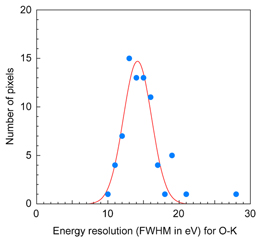Research Abstract
超伝導検出器を使って可能になったSiC中の窒素ドーパントのX線吸収端近傍構造分光
X-ray absorption near edge spectroscopy with a superconducting detector for nitrogen dopants in SiC
2012年11月14日 Scientific Reports 2 : 831 doi: 10.1038/srep00831

蛍光収量X線吸収微細構造(FY-XAFS)は、機能性材料中の特定元素周辺の原子スケール局所構造を調べるために広く用いられている。しかし、従来のFY-XAFS計測装置は、半導体X線検出器のエネルギー分解能が不十分なため、例えばワイドギャップ半導体中のドーパントといった微量軽元素を計測できない。計測分析手段がないことは、ワイドギャップ半導体デバイス開発における障害であった。今回我々は、半導体検出器の理論限界を超える性能の超伝導トンネル接合アレイ検出器を搭載したXAFS (SC-XAFS)装置を開発して、SiC中のn型ドーパントN原子(4 ×1019 cm−3)のX線吸収端近傍構造(XANES)測定に初めて成功した。500°CでNをイオン注入した4H-SiC基板とその後熱処理した基板のXANESスペクトルを第一原理多重散乱理論計算の結果と比較することにより、イオン注入直後(加熱処理前)の状態で、N原子はほぼ完全にCサイトを置換しており、局所的にCN領域が存在しうることが示されている。SiCへのドーピングでは、熱処理によりNの格子位置置換が進むのではなく、イオン注入直後にNはCサイトを占めており、熱処理は欠陥回復に必要であることが示されている。SC-XAFS装置は、省エネルギーが可能なワイドギャップ半導体や多くの機能性材料の開発において、ドーピング技術の確立に重要な役割を果たすものと期待される。
大久保 雅隆1, 志岐 成友1, 浮辺 雅宏1, 松林 信行1, 北島 義典2 & 長町 信治3
- 独立行政法人産業技術総合研究所 計測フロンティア研究部門 超分光システム開発研究グループ
- 大学共同利用機関法人 高エネルギー加速器研究機構 物質構造科学研究所 放射光科学研究施設
- 株式会社イオンテクノセンター
Fluorescence-yield X-ray absorption fine structure (FY-XAFS) is extensively used for investigating atomic-scale local structures around specific elements in functional materials. However, conventional FY-XAFS instruments frequently cannot cover trace light elements, for example dopants in wide gap semiconductors, because of insufficient energy resolution of semiconductor X-ray detectors. Here we introduce a superconducting XAFS (SC-XAFS) apparatus to measure X-ray absorption near-edge structure (XANES) of n-type dopant N atoms (4 ×1019 cm−3) implanted at 500°C into 4H-SiC substrates annealed subsequently. The XANES spectra and ab initio multiple scattering calculations indicate that the N atoms almost completely substitute for the C sites, associated with a possible existence of local CN regions, in the as-implanted state. This is a reason why hot implantation is necessary for dopant activation in ion implantation. The SC-XAFS apparatus may play an important role in improving doping processes for energy-saving wide-gap semiconductors and other functional materials.

